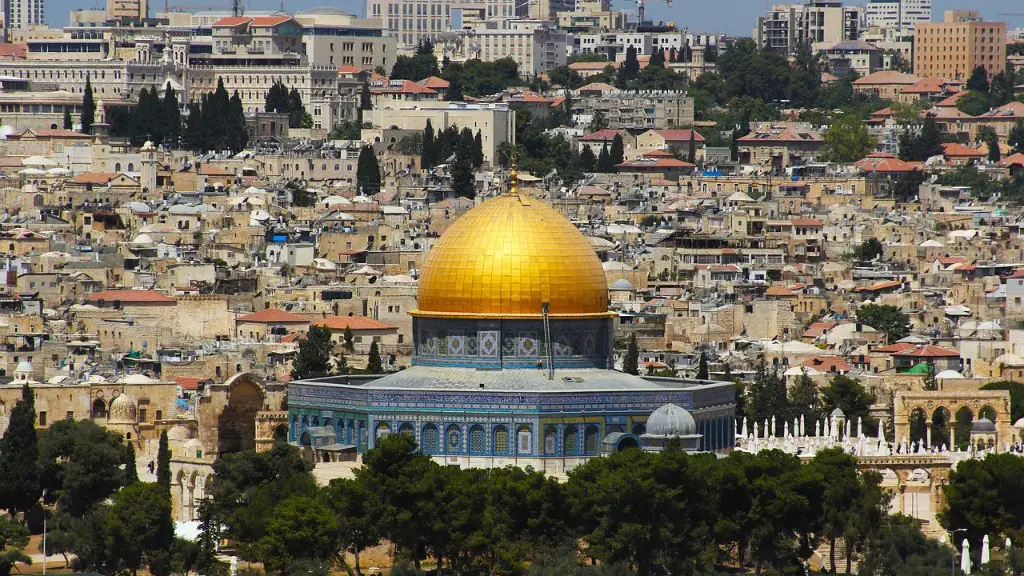What’s The Origin Of Hinduism
Hinduism is one of the oldest religious traditions in the world. It is one of the five major religions alongside Christianity, Islam, Judaism, and Buddhism. With roughly 1.3 billion adherents of Hinduism it is considered the world’s third largest religion. Hinduism does not have a single founder and does not have a single source of doctrine, although elements of Hinduism’s beliefs and practices are shared among other ancient religious traditions including Hinduism.
It is believed that Hinduism originates from the Vedic period in the Indian subcontinent- from ca. 1500 BCE to ca. 500 CE. This period is known as the foundational period of Hinduism as it is during this period that the core beliefs of Hinduism were developed. Early Hinduism during the Vedic period primarily revolved around the Vedas – a collection of ancient texts. It is believed that these texts were composed between 1500 BCE and 500 BCE.
Hinduism is often referred to as Sanatana Dharma- which refers to the idea that it is an eternal, timeless law. This is an important concept for Hindus as it conveys the idea that Hinduism is not subject to change and that its practices have a validity regardless of time. The Vedas have remained the primary source of Hinduism since the Vedic period.
Hinduism has also been heavily influenced by the many regional cultures that have been present in the Indian subcontinent throughout its history. This is evident in the various regional expressions of Hinduism that exist today and each of these regional expressions has its own unique practices, rituals, and customs.
Despite the prevalence of regional expressions of Hinduism, a set of shared beliefs and concepts are found throughout the various Hindu traditions. This includes the belief in Karma, Dharma, and the cycle of birth and rebirth. It also includes the recognition of a supreme being who is known by various names including Brahman, Vishnu, and Shiva. Devotion to these gods as well as practices such as yoga, pilgrimages, and vegetarianism are also significant aspects of Hinduism.
Modern Hinduism differs from the early Vedic form in various ways. Concepts such as yoga and meditation which were developed centuries after the Vedic period have become commonplace in the context of Hinduism. Similarly, many of the deities which are worshipped in modern Hinduism were not worshipped in the early Vedic period.
Modern Scholarly Interpretations Of Hinduism
Modern Hinduism has come to be defined by the various scholarly interpretations of Hinduism that are available in the contemporary world. In academic circles, Hinduism is often interpreted as an amalgamation of various different beliefs and ideologies, as well as an example of cultural and religious syncretism. This interpretation has been heavily influenced by the colonial period in India and the importance that colonial scholarship placed on Indian religion.
Scholars such as Eck and Flood have proposed theories of ‘multiple Hinduisms’, arguing that there is no single, homogenous expression of Hinduism. Meanwhile, Muirhead, Maitra and Vidyarnava have sought to place Hinduism within frameworks such as transnationalism, globalisation and poststructuralism.
Developments such as the recent emphasis on diasporic Hinduism have challenged traditional interpretations of Hinduism as a uniformly static religion. This has led to new interpretations of Hinduism which emphasise the changing nature and scope of Hinduism, as well as its ability to adapt to new social, political and cultural contexts.
Studies on Hinduism are varied in their scope and subject matter, and this tendency towards eclecticism has enabled views on Hinduism which are far more dynamic and open than those which were widespread several decades ago. This has set the stage for a more nuanced and precise understanding of Hinduism.
Hinduism And South Asia
Hinduism is also closely intertwined with the cultures, history, and politics of South Asia. In some parts of South Asia, such as India, Pakistan, and Nepal, Hinduism is the dominant religion. In other parts of the region, such as Sri Lanka and Bangladesh, it is a significant minority religion.
Hinduism is seen as integral to the identity of many South Asians and is a major source of cultural pride for many. This is reflected by the prominence of Hindu symbols in South Asian art, literature, language, and architecture. Furthermore, Hindu festivals and celebrations are an important part of South Asian culture, and are celebrated by Hindus and non-Hindus alike.
The practice of Hinduism has been heavily shaped by the various political and social movements in South Asia over time. This is particularly evident in the period of British colonial rule, where efforts were made to impose a Westernised view of Hinduism and to separate it from its regional and regional expressions.
The colonial period also saw a resurgence in the practice of Hinduism, as part of an attempt to reassert an indigenous identity in the face of colonial domination. This was furthered by the growth of Indian nationalist movements in the early 20th century, which sought to mobilise people around a shared Hindu identity.
The relationship between Hinduism and South Asia is complex, and this complexity is reflected in the various interpretations of Hinduism which exist today. It is clear, however, that Hinduism will continue to play a significant role in the culture and politics of South Asia for many years to come.
Hinduism In A Globalised World
Hinduism has been able to maintain its place in a globalised world due to its ability to adapt to various changes in its social, political, and cultural contexts. It has also been able to do this without compromising its core principles and values. Today, Hinduism is practiced in numerous countries around the world, reflecting the wide-reaching influence of the religion.
This is due in part to the extensive diaspora of Hindus, which has led to the development of new expressions of Hinduism in various parts of the world. Globalisation has enabled this diaspora to interact with and influence each other, furthering the development of Hinduism in various contexts.
The development of various forms of Hindu digital media and the use of technology has also enabled Hindus to more easily share and disseminate their views and insights on Hinduism. These developments have enabled Hinduism to maintain its relevance in the contemporary world and have also contributed to the growth of Hinduism in various parts of the world.
Hinduism And Modernity
Hinduism in its modern form differs significantly from its pre-modern form. This is in large part due to the influence of modernity and globalization on the Hindu world. This is reflected by the changing nature of Hindu practices, beliefs, and institutions.
For instance, the rise of Hindu nationalism and the increased emphasis on the Aryan race in modern Hinduism is a product of modern thought and ideas. Similarly, the development of yoga and other such practices as part of modern Hinduism can be seen as a result of modernity’s influence on Hindu thought.
It is clear that Hinduism has undergone significant changes over the last few centuries, and will likely continue to do so in the future. As time passes and society continues to progress, Hinduism will have to continue to adapt if it wishes to remain relevant and vital in the modern world.
Conclusion
Hinduism is a complex and varied religious tradition which has maintained its relevance for millennia. It is a tradition that is constantly evolving as it adapts to its various social, political, and cultural contexts. It is this ability to adapt and transform that has enabled Hinduism to remain essential to the lives of countless people across the world.


